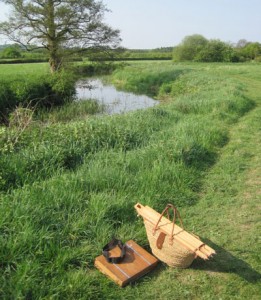Simon, who’s been painting out doors for some time, will support anyone who has the time to listen to him. From choosing where and what to paint, how to set up your painting, how to complete and when to stop. Each artistic discipline has it’s own set of insights and blind alleys and painting out doors is no exception. Simon will guide you through this lumpy terrain pointing out where dragons be and helping you to complete a painting which will either be a keeper or at least a firm step along the way.
Plein Air Painting
Painting out of doors tends to be referred to these days as ‘Plein Air’ painting in deference to the French masters such as Monet and Cezanne who along with many other impressionists spent much of their time under a sun hat. Constable is famous for completing large works outdoors and his works inspired the Barbizon and Impressionist schools that followed. These days Plein Air painters gather in their hundreds for competitive events in America and it’s beginning to pick up momentum in the UK too.
When you are starting out it can seem a little daunting setting up an easel in a public space and wrestling with your art under the scrutiny of the passing throng. People do stop for a chat which can be distracting but then again they may be future customers and usually have nice things to say.
However having other artists around you gives a much greater sense of security which is one way in which these sorts of events can be so supportive. Seeing how other artists deal with the scene is also key in ones own development. So many of us are visual learners where watching how someone else does something is the best way to acquire the skills ourselves. Simon will be happy to demonstrate – or talk as he paints, give support where requested or leave you to get along as you wish.
What to bring
Simon paints in oils, usually on boards or panels. You are free to choose your own media but here is a typical setup for an oil painter:
- Something to paint on – canvas, canvas boards or gessoed panels. You may wish to put a wash of raw umber down in advance.
- An easel. Many use French Box Easels, others get by with a sketching easel or a modern arrangement that uses a photographic tripod. We have a few sketching easels if you don’t have your own – let us know.
- Paints – if you can bear it get artist quality, you won’t regret it. A standard modern palette would be: Titanium White, Ultramarine Blue, Prussian or Pthalocyanin Blue, Cadmium red, Alizarin Crimson, Cadmium Yellow and Cadmium Yellow Pale. Earth colours are also invaluable, a dark earth such as Raw Umber and, as we learned on our workshop with David Sawyer, Sap Green or Terre Vert are excellent colours of convenience. Add to this Yellow Ochre, Naples Yellow and Cobalt Violet and you’ll be good to go. Simon will be happy to squeeze any missing colours out for you from his paint box.
- Brushes – half a dozen bristle brushes in different sizes will do. A small sable or synthetic is handy for drawing out or adding accents.
- A palette. You need something to mix your paints on. If you buy a new wooden one do season it with some linseed oil first, they can be annoyingly absorbent when new.
- Solvents: white spirit, turps or Zestit will be needed for cleaning brushes and to thin paint. You’ll need a jam jar or similar to put them in too.
- Linseed oil – not everyone bothers with this but it’s good to have on hand.
- Rags or Kitchen towels – to wipe your brushes and clean up.
- A palette knife, essential for cleaning your palette
- A pocket mirror is used by some to check proportion and composition.
In an ideal world you’d have a white parasol above your work but in practice setting up either in the shade or with the sun before you will work. It can be difficult painting with the sun shining on your work.
Clothing
Whatever the weather please remember that we do live in England. So make sure that you bring at least one more pullover or fleece than you think you’ll need. Standing still for several hours even on a mild day can chill you to the bone. Similarly, lightweight shoes (eg Converse) will not keep feet warm that are in contact with the cool earth. You may need a sunhat or baseball cap which will keep the sun out of your eyes and sun cream, your hands and arms can catch the sun fiercely when painting. It may also be as well to bring some light rainwear.


